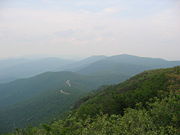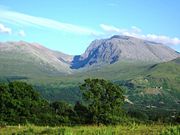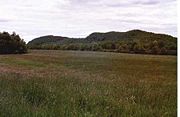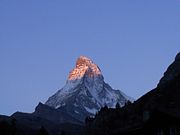Mountain
2008/9 Schools Wikipedia Selection. Related subjects: Geology and geophysics
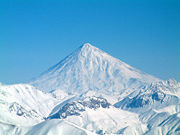
A mountain is a landform that extends above the surrounding terrain in a limited area, with a peak. A mountain is generally steeper than a hill, but there is no universally accepted standard definition for the height of a mountain or a hill although a mountain usually has an identifiable summit. Mountains cover 64% of Asia, 36% of North America, 25% of Europe, 22% of South America, 17% of Australia, and 3% of Africa. As a whole, 24% of the Earth's land mass is mountainous. 10% of people live in mountainous regions. Most of the world's rivers are fed from mountain sources, and more than half of humanity depends on mountains for water.
The adjective montane is used to describe mountainous areas and things associated with them.
Definitions
Some authorities define a mountain as a peak with a topographic prominence over a defined value: for example, according to the Britannica Student Encyclopedia, the term "generally refers to rises over 2,000 feet (610 m)". The Encyclopædia Britannica, on the other hand, does not prescribe any height, merely stating that "the term has no standardized geological meaning".
In the United Kingdom
In England and Wales the Department for Environment, Food and Rural Affairs has defined "mountain" (as a mass noun) as all land over 600 metres for the purposes of right to roam legislation. The Land Reform (Scotland) Act 2003 does not appear to draw this distinction, and in Scotland the term "mountain" is more subjective, often being used for hills exceeding 3,000 feet (914.4 m) listed as Munros. In the United Kingdom the term "hill" is commonly used for all hills and mountains, regardless of height.
In the United States
In the United States, the U.S. Board on Geographic Names lists hundreds of landscape features under 1,000 feet (305 m) (some as low as 100 feet) named as "mountains." This is true for all parts of the United States, including the west coast where such lofty ranges as the Cascade Mountains dominate. And yet the Board does not attempt to distinguish between such features as mountains, hills, or other prominences, and simply categorizes all of them as summit, regardless of what they are called or how high they are. However, the Board does list and categorize such low mountain ranges as the Mount Tom Range (with a high point of 1,200 feet; 366 m) as range.
Height
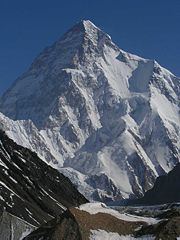
The height of a mountain is measured as the elevation of its summit above mean sea level. The Himalayas average 5 km above sea level, while the Andes average 4 km. The highest mountain on land is Everest, 8,848 metres (29,030 ft) in the Himalayas.
Other definitions of height are possible. The peak that is farthest from the centre of the Earth is Chimborazo in Ecuador. At 6,267 metres (20,560 ft) above sea level it is not even the tallest peak in the Andes, but because Chimborazo is very close to the equator and the Earth bulges at the equator, it is 2,150 metres (7,100 ft) further away from the Earth's centre than Everest. The peak that rises farthest from its base is Mauna Kea on Hawaii, whose peak is 10,200 metres (33,500 ft) above its base on the floor of the Pacific Ocean. Mount Lamlam on Guam also lays claim to the tallest mountain as measured from it base. Although its peak is only 406 metres (1,330 ft) above sea level, it measures 11,530 metres (37,830 ft) to its base at the bottom of the Marianas Trench.
Even though Everest is the highest mountain on Earth today, there have been much taller mountains in the past. During the Precambrian era, the Canadian Shield once had mountains 12,000 m (39,370 ft) in height that are now eroded down into rolling hills. These formed by the collision of tectonic plates much like the Himalaya and the Rocky Mountains.
At 26 kilometres (85,000 ft) (Fraknoi et al., 2004), the tallest known mountain in the solar system is Olympus Mons, located on Mars and is an ancient volcano. Volcanoes have been known to erupt on other planets and moons in our solar system in our life-times (volcanoes on Venus for example, constantly erupt) and some of them erupt ice instead of lava. Several years ago, the Hale telescope recorded the first known live images of a volcano erupting on a moon in our solar system.
Characteristics
High mountains, and mountains located closer to the Earth's poles, have elevations that exist in colder layers of the atmosphere. They are consequently often subject to glaciation and erosion through frost action. Such processes produce the popularly recognizable mountain peak shape. Some of these mountains have glacial lakes, created by melting glaciers; for example, there are an estimated 3,000 glacial lakes in Bhutan.
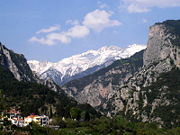
Sufficiently tall mountains have very different climatic conditions at the top than at the base, and will thus have different life zones at different altitudes. The flora and fauna found in these zones tend to become isolated since the conditions above and below a particular zone will be inhospitable to those organisms. These isolated ecological systems are known as sky islands and/or microclimates. Tree forests are forests on mountain sides which attract moisture from the trees, creating a unique ecosystem. Very tall mountains may be covered in ice or snow.
Mountains are colder than lower ground, because the Sun heats Earth from the ground up. The Sun's radiation travels through the atmosphere to the ground, where Earth absorbs the heat. Air closest to the Earth's surface is, in general, warmest (see lapse rate for details). Air as high as a mountain is poorly warmed and, therefore, cold. Air temperature normally drops 1 to 2 degrees Celsius (1.8 to 3.6 degrees Fahrenheit) for each 300 meters (1000 feet) of altitude.
Mountains are generally less preferable for human habitation than lowlands; the weather is often harsher, and there is little level ground suitable for agriculture. At very high altitudes, there is less oxygen in the air and less protection against solar radiation (UV). Acute mountain sickness (caused by hypoxia - a lack of oxygen in the blood) affects over half of lowlanders who spend more than a few hours above 3,500 meters (11,483 feet).
A number of mountains and mountain ranges of the world have been left in their natural state, and are today primarily used for recreation, while others are used for logging, mining, grazing, or see little use of any sort at all. Some mountains offer spectacular views from their summits, while others are densely wooded. Summit accessibility ranges from mountain to mountain; height, steepness, latitude, terrain, weather, and the presence or lack thereof of roads, lifts, or tramways are all factors that affect accessibility. Hiking, backpacking, mountaineering, rock climbing, ice climbing, downhill skiing, and snowboarding are recreational activities typically enjoyed on mountains. Mountains that support heavy recreational use (especially downhill skiing) are often the locations of mountain resorts.
Types of mountains
Mountains can be characterized in several ways. Some mountains are volcanoes and can be characterized by the type of lava and eruptive history. Other mountains are shaped by glacial processes and can be characterized by their glaciated features. Still others are typified by the faulting and folding of the Earth's crust, or by the collision of continental plates via plate tectonics (the Himalayas, for instance). Shape and placement within the overall landscape also define mountains and mountainous structures (such as butte and monadnock). Finally, many mountains can be characterized by the type of rock that make up their composition. More information on mountain types can be found in List of mountain types.
Geology
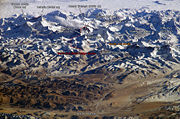
A mountain is usually produced by the movement of lithospheric plates, either orogenic movement or epeirogenic movement. The compressional forces, isostatic uplift and intrusion of igneous matter forces surface rock upwards, creating a landform higher than the surrounding features. The height of the feature makes it either a hill or, if higher and steeper, a mountain. The absolute heights of features termed mountains and hills vary greatly according to an area's terrain. The major mountains tend to occur in long linear arcs, indicating tectonic plate boundaries and activity. Two types of mountain are formed depending on how the rock reacts to the tectonic forces – block mountains or fold mountains.
The compressional forces in continental collisions may cause the compressed region to thicken, so the upper surface is forced upwards. In order to balance the weight of the earth suface, much of the compressed rock is forced downwards, producing deep "mountain roots"[see the Book of "Earth", Press and Siever page.413]. These roots are deeply embedded in the ground, thus, a mountain have a shape like peg [See Anatomy of the Earth, Cailleus page.220]. Mountains therefore form downwards as well as upwards (see isostasy). However, in some continental collisions part of one continent may simply override part of the others, crumpling in the process.
Some isolated mountains were produced by volcanoes, including many apparently small islands that reach a great height above the ocean floor.
Block mountains are created when large areas are widely broken up by faults creating large vertical displacements. This occurrence is fairly common. The uplifted blocks are block mountains or horsts. The intervening dropped blocks are termed graben: these can be small or form extensive rift valley systems. This form of landscape can be seen in East Africa, the Vosges, the Basin and Range province of Western North America and the Rhine valley. These areas often occur when the regional stress is extensional and the crust is thinned.
The mid-ocean ridges are often referred to as undersea mountain ranges due to their bathymetric prominence.
Where rock does not fault it folds, either symmetrically or asymmetrically. The upfolds are anticlines and the downfolds are synclines; in asymmetric folding there may also be recumbent and overturned folds. The Jura mountains are an example of folding. Over time, erosion can bring about an inversion of relief: the soft upthrust rock is worn away so the anticlines are actually lower than the tougher, more compressed rock of the synclines.
